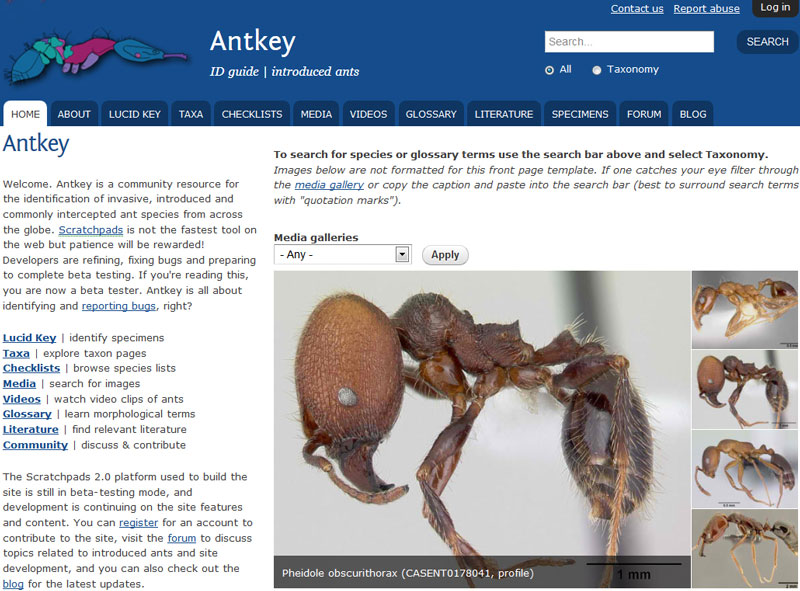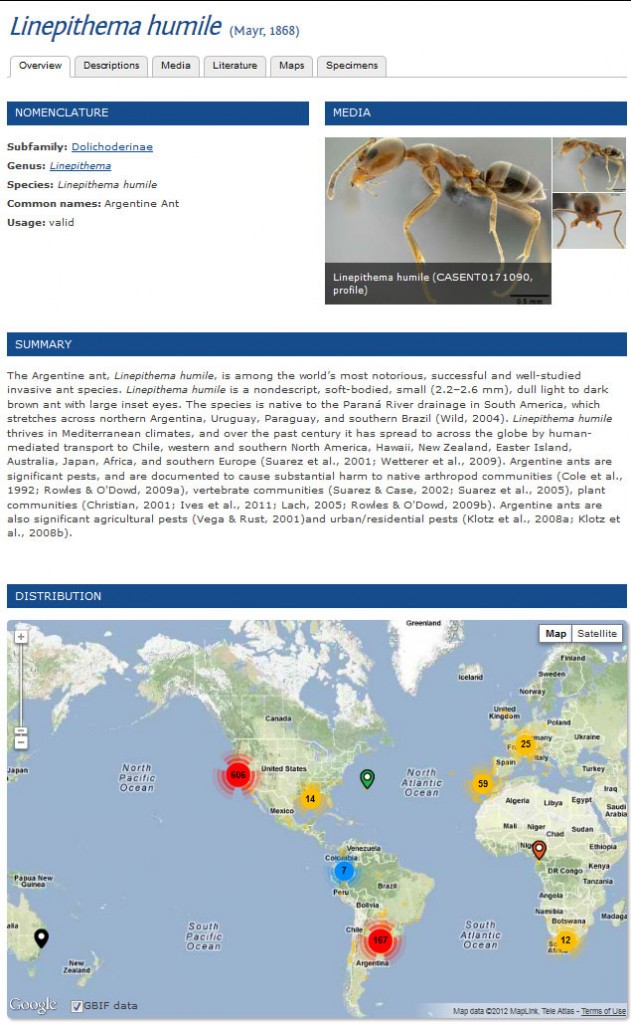Andy Suarez and I are excited to announce the release our Antkey.org project. The project was funded by USDA-APHIS-PPQ-CPHST and the Encyclopedia of Life (EOL) Rubenstein Fellowship program to provide an online identification guide to invasive, introduced and commonly intercepted ants.
Download USDA Antkey Announcement
Over 15,000 species of ants have been described, and more than 200 have established populations outside of their native ranges. A small subset of these have become highly destructive invaders including five which are currently listed among the world’s 100 worst invasive species. Unfortunately, detection of non-native ants is hampered by the taxonomic specialization required for accurate species identification. Antkey seeks to mitigate the spread of established introduced ants and prevent the incursion of new introductions by providing quarantine personnel, inspectors and conservation biologists with a user-friendly identification resource specifically designed for non-specialists.
Antkey focuses on over 115 ant species that are introduced, invasive or commonly intercepted in North America and the Pacific Islands. Features include an interactive Lucid key, dynamically generated species pages, a searchable media collection of over 1150 images, over 70 live video clips of introduced ants, a fully illustrated glossary with over 400 terms, a searchable database of introduced ant literature, over 12,000 specimen records of introduced ants imported from Antweb (www.antweb.org), and community features such as blogs, discussion forums and comment options.
The interactive Lucid key allows users to start at multiple entry points, skip ambiguous or difficult characters, and keep track of the choices already made. Novice users can use the ‘best’ feature to determine which available characters will lead to the most parsimonious pathway. More advanced users can skip straight to subfamily or genus. The characters are illustrated with original line drawings and link to glossary definitions and additional specimen photographs.
The Antkey taxonomic classification includes 8 subfamilies, 43 genera and 116 valid species. Taxon pages include tabs for overview, descriptions, media, maps, literature and specimens. In addition to original diagnostic descriptions and overview sections, all the species pages dynamically import relevant articles from the Encyclopedia of Life (www.eol.org) and specimen images from Antweb. The Google maps are dynamically generated from specimen data imported from Antweb and distribution data imported from GBIF.
The media feature contains over 1150 images and uses a faceted search tool that allows users to filter images by media gallery, taxonomic name, keywords, description and creator. Each thumbnail links to a lightbox window that displays the standard scaled image and associated metadata, and also offers a link to download the original, full-sized image. All images tagged with a taxon name automatically appear on that taxon’s species page.

Media feature in Antkey allows users to filter their searches based on morphological terms, taxonomic names, image type, media galleries and keywords.
The site includes approximately 75 video clips of 22 species. There are many important identification characters for ant species that are only possible to detect while the ant is alive. The standardized thirty-second video clips feature ants feeding at and recruiting to baits, foraging in natural environments, and entering and exiting their nests. The videos can be downloaded by users or embedded in other webpages.
A fully illustrated glossary of over 400 terms, including all the character states used in the Lucid key, allows users to quickly learn the important morphology needed to make accurate identifications. The terms are integrated throughout the site so that whenever one appears in the text the user can point to it and the definition will automatically display.
One of the greatest strengths of Antkey is that it was developed using the Scratchpads platform. Scratchpads (http://scratchpads.eu/) is a social networking platform that allows communities to bring taxonomic information together without the limitations of traditional paper-based publications. Web systems and content can be developed and updated in minutes so websites can reflect the latest knowledge of a particular group. The platform also allows multiple authors to create and edit content without using any html code. The Scratchpads platform relies on the content management system Drupal (http://drupal.org/) for its underlying architecture.


